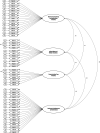The Postpartum Specific Anxiety Scale: Confirmatory factor analyses and relationships with birth experience
- PMID: 35488935
- PMCID: PMC9055017
- DOI: 10.1007/s00737-022-01233-9
The Postpartum Specific Anxiety Scale: Confirmatory factor analyses and relationships with birth experience
Abstract
The Postpartum Specific Anxiety Scale [PSAS] was developed and validated as a research tool with a four-factor structure; with predictive validity corroborated in studies examining infant-feeding and maternal bonding outcomes. The PSAS has not been examined in relation to birth experiences. We aimed to confirm the PSAS four-factor structure and examine these domains of anxiety in relation to subjective and objective birth experiences. Postpartum mothers (≤ 12-months; N = 500) completed the PSAS alongside measures of subjective birth satisfaction and objective obstetric interventions/complications. Confirmatory factor analyses [CFA] tested eight models, theoretically derived from the preceding exploratory work. Structural equation modelling [SEM] tested associations between each PSAS factor and birth experience variables in the best-fitting model. An identical 51-item four-factor model fits the data well. SEM analyses revealed associations between lower perceptions of quality of intrapartum care and increased maternal competence and attachment anxieties, practical infant care anxieties, and infant safety and welfare anxieties. High subjective stress and negative emotional response to labour were associated with increased psychosocial adjustment to motherhood anxieties. Specific associations were found between neonatal care unit admission and practical infant care anxieties; and infant asphyxia and infant safety and welfare anxieties. Findings confirm construct and convergent validity of the four-factor PSAS and its use in measuring postpartum anxiety. Unique associations were also identified, indicating specific subjective and objective experiences occurring during birth may elicit a differential anxiety response, in that they are related to specific forms of postpartum anxiety which occur during the first postpartum year.
Keywords: Birth experience; Birth satisfaction; Child-bearing specific measures of mood; Maternal anxiety; Psychometrics.
© 2022. The Author(s).
Conflict of interest statement
Sergio A. Silverio (King’s College London) is currently supported by the National Institute for Health Research Applied Research Collaboration South London [NIHR ARC South London] at King’s College Hospital NHS Foundation Trust. The views expressed are those of the authors and not necessarily those of the NIHR or the Department of Health and Social Care.
Similar articles
-
Psychometric Properties and Factorial Structure of Postpartum-Specific Anxiety Scale (PSAS) Within Arabic Language in a Palestinian Context.Matern Child Health J. 2023 Sep;27(9):1589-1598. doi: 10.1007/s10995-023-03747-9. Epub 2023 Jul 1. Matern Child Health J. 2023. PMID: 37392355
-
Associations between prematurity, postpartum anxiety, neonatal intensive care unit admission, and stress.Front Psychiatry. 2024 Feb 23;15:1323773. doi: 10.3389/fpsyt.2024.1323773. eCollection 2024. Front Psychiatry. 2024. PMID: 38463430 Free PMC article.
-
The Postpartum Specific Anxiety Scale: development and preliminary validation.Arch Womens Ment Health. 2016 Dec;19(6):1079-1090. doi: 10.1007/s00737-016-0658-9. Epub 2016 Aug 29. Arch Womens Ment Health. 2016. PMID: 27571782 Free PMC article.
-
Impact of mobile health interventions during the perinatal period on maternal psychosocial outcomes: a systematic review.JBI Evid Synth. 2020 Jan;18(1):30-55. doi: 10.11124/JBISRIR-D-19-00191. JBI Evid Synth. 2020. PMID: 31972680
-
Postpartum stress and infant outcome: A review of current literature.Psychiatry Res. 2020 Feb;284:112769. doi: 10.1016/j.psychres.2020.112769. Epub 2020 Jan 9. Psychiatry Res. 2020. PMID: 31962260 Review.
Cited by
-
Postpartum depression-an exploratory mixed method study for developing an indigenous tool.BMC Pregnancy Childbirth. 2024 Jan 10;24(1):49. doi: 10.1186/s12884-023-06192-2. BMC Pregnancy Childbirth. 2024. PMID: 38200434 Free PMC article.
-
Can Pregnancy Experience Predict Birth Experience, Postpartum Depression and Anxiety? A Prospective Descriptive Study.Nurs Open. 2024 Dec;11(12):e70116. doi: 10.1002/nop2.70116. Nurs Open. 2024. PMID: 39642152 Free PMC article.
-
Virtual reality interventions designed to support parents during and throughout the first year after birth: A scoping review.Digit Health. 2024 Apr 22;10:20552076241245373. doi: 10.1177/20552076241245373. eCollection 2024 Jan-Dec. Digit Health. 2024. PMID: 38655377 Free PMC article.
References
-
- Azzopardi D, Strohm B, Marlow N, Brocklehurst P, Deierl A, Eddama O, Goodwin J, Halliday HL, Juszczak E, Kapellou O, Levene M, Linsell L, Omar O, Thoresen M, Tusor N, Whitelaw A, Edwards AD, for the TOBY Study Group Effects of hypothermia for perinatal asphyxia on childhood outcomes. N Engl J Med. 2014;371(2):140–149. doi: 10.1056/NEJMoa1315788. - DOI - PubMed
-
- Baptie G (2021) Birth Trauma: A mixed-methods investigation [Unpublished doctoral thesis]. University of Plymouth
-
- Bauer A, Parsonage M, Knapp M, Lemmi V, Adelaja B (2014) The costs of perinatal mental health problems. London School of Economics and Political Science and Centre for Mental Health
MeSH terms
LinkOut - more resources
Full Text Sources
Medical


